Posts Tagged ‘creating leadership’

(Thanks George, for this month’s post & prompt!)
There has been a lot of talk on the idea that education as a whole takes a long time to change. As an educator, this is a challenging notion, since we are seeing many people doing some amazing things that did not exist when I was a student. Change is happening but sometimes it is hard to see when you are in the middle of the process.
Some things are out of the hands of schools. Budgets and government decisions can make creating new and better learning environments for students tough, but not impossible. Educators are not powerless, and in some cases, more powerful that ever. The story of education can not only be told from the perspective of educators, but also from the students that are currently in the system. Although there is still a lot of work to do (as there always will be in organizations that focus on continuous learning and have an emphasis on becoming “innovative”), there are also opportunities in education, now more than ever, that we will need to take advantage of and create a different path.
Here are some of the challenges we have had in the past and how we can tackle them
1. Isolation is the enemy of innovation.
Education has traditionally been an isolating profession where we get some time together, but not nearly enough. Even if we wanted to change this significantly, in most cases, the current physical structures do not allow us to work with other educators. Some administrators have been very innovative in their planning of teacher prep time and have embedded collaboration time into the regular school day, but it is not necessarily enough to make a significant impact.
How so many educators have shifted this “norm” is by using social media spaces to connect and learn from educators all over the world, and making a significant difference in their own classrooms, and creating much more engaging and empowering learning spaces. Isolation is now a choice educators make. Where the shift really has to happen is using things like Twitter is for educators to connect and share learning that is happening with educators in their own school. I challenged people to do the following (as shared in this visual from Meredith Johnson);

We need to make this happen and create transparency in our own classrooms.
How does a song like “Gangnam Style” go so viral that most people around the world not only know the words but the dance moves? Social media. If a song can spread so quickly, so can great learning.
Make it go viral.
2. A continuous focus on what is wrong, as opposed to what is right.
Think about the traditional practice of what school has done with many of our students. If they struggle with the subject of math, we often send the more math homework to do at home. Does this really make sense? If they are struggling at school, making them struggle at home with the same content is often counter-intuitive. It is not that we shouldn’t struggle, but it is important that we are very thoughtful of how we spend our energy.
The shift that has happened with not only our students, but also our schools, is focusing upon building upon strengths as opposed to focusing solely on weaknesses. This is imperative as building upon strengths often helps us to not only build competence, but also confidence which leads us to the mindset that we are more open to tackle our other challenges along the way.
I love this quote from Forbes on putting people in the right positions to be successful:
Leadership is a privilege, not a right, and we need to treat it as such. Leadership means encouraging people to live up to their fullest potential and find the path they love. That, and only that, will create a strong culture and sustainable levels of innovation.
Many organizations outside of education are hiring not on need, but finding the best people and empowering them based upon their strengths. Schools should try to do their best to follow suit and put people to be in the best situations to not only do well, but to lead.
3. Experience is a very powerful teacher.
I remember sitting and listening to Bruce Dixon at a conference and something he said has always stuck out to me:
In no other profession in the world do you sit and watch someone else do your job for 16 years before you go and do it yourself.
Wow. That is a powerful message and shows why so many new teachers aren’t coming into school with all of these “innovative ideas” and changing our school system like so many people predicted. Many educators simply replicate their experience as a student. If you think about it, at least one-third of many teachers educational experience is as a student, not a teacher. That is a tough thing to overcome, but not impossible.
Innovation has no age barrier, and if we can tweak the experience for educators in their professional learning, they are more likely to change the experience for their students. Writing ideas about “21st century classrooms” on gigantic pieces of paper with a felt marker is not going to create cultural shifts; changing experiences will.
People are starting to look differently at professional learning, and create experiences that are much different from what I first experienced as a teacher. I think a major reason for this shift (going back to point 1) is that educators are seeing the shift in practices in so many other organizations, and are trying to create a different practice where more educators are not really focused on teaching as much as they are about learning. This empathy is crucial since to become a master teacher, you must become a master learner.
Changing experiences to shift the focus on the learner from the teacher helps to disrupt routine. If you would want to create an environment where students would want to be a part of your classroom, we have to experience what learning could look like for ourselves and start from a point of empathy.
One shift that was not mentioned was the mindset of looking at obstacles as opportunities. As mentioned earlier, not everything is in our control, but as educators know, they can make an impact every single day. It is not always easy, and teaching can be a very daunting and tiring job, but I believe that every day we can make a difference if we choose. Having that mindset is the only way that we will ever truly be able to make a powerful change for ourselves and our students.
For this month’s prompt, write about how you already are, or are going to, address the challenges discussed above.
Amber

How Do You Manage Your Time As Principal?
Many things in life change and evolve, but the total time in a day continues to be 24 hours. Part of being the best parent, teacher, administrator we can be is maximizing that time while eating and getting enough rest to live a healthy and rewarding lifestyle. How we use our time as school leaders has a direct impact on what we are able to achieve as students, staff and an organization as a whole. Balance is not easy and some days and weeks it looks different from others. When you’re a principal, one incident that occurs just after the morning announcements can consume a good part of the day when you had so many things on the day’s docket.
As leaders, we know this is going to happen. We know one of the beauties of “the job” is that it is unpredictable, and you never know what is going to happen when you walk into the school each morning. The awesome responsibility we have is to proactively plan for circumstances around professional development, school safety, arrival/dismissal, special education services, staff culture and morale, student/staff/parent relatiobships, custodial, secretarial and the overall day to day management of a busy school building. Now matter what level of school you work at, the day goes by fast and skipping lunches and bathroom breaks becomes the norm when you’re “in the weeds” from time to time.
Don’t choose to go at it alone
At school, much like at home, I’ve found it beneficial to including the support around me in my plans, goals and deadlines. This takes an extra helping of transparency in the day to day work, but in the end when you communicate regularly to your “work family,” you have your secretary, custodian, teacher leaders and others necessary seeing through a similar perspective. At home, my wife and I have a shared Google Calendar on our phones, and home events are booked just like those at work.
This month’s #SAVMP is to take a closer look at your own proactive time management as a school leader and as a person. One resource that I’ve used over the years to help me prioritize the most important parts of my day (where I want to invest my time the most) is The Big Rocks Principal Management. I read this Kim Marshall piece in Principal Magazine back in March of 2008, and it stuck with me. I actually brought a vase and rocks in to live on my desk as as a constant visual reminder of where my mind needs to be focused.
CLICK IMAGE TO VIEW PDF including 10 Big Rocks for Principals

Tools, like a good workout program can put you in a position to be successful, but you have to do the work. There are quite a few tools available that might support efforts to focus your time on what is important. Obviously “there’s an app for that” here in 2015, but again maximizing your time is about mindset and discipline. We can’t expect any tools or app to do the heavy lifting for us. Check out a few “pomodoro apps” (can be downloaded in the
Video on the Pomodoro Technique via Ignite Phoenix by Greg Head
Two recommended tools to get you thinking…

Focus app – Pomodoro
1) I’ve been using the FOCUS pomodoro app since grad school, and use it more at home than at school to get writing, reading and special projects completed.
2) Take control of your Google email with http://sortd.com. On Twitter follow @GetSortd.

Image credit: computerrelatedsolutions.com
How do you manage your time? What have you found as helpful? What has been a roadblock for you? Any tools out there that you’d recommend to a colleague to keep The Big Rocks in focus each day?
Dr. @Joe_Mazza serves as the Leadership Innovation Manager at @PennGSE’s Mid-Career Doctoral Program in Educational Leadership @MCDPEL. You can follow the work of the MCDPEL Innovations Lab here.

A couple of reminders for this initial month…
- Make regular contact with your mentor/mentee’s…vox, tweet, email…whatever you’d like! Develop relationships that will allow for transparency of strengths and weaknesses.
- Write & reflect towards the monthly prompt. Prompts will be posted the first week of the month. You have the entire month to respond.
- Connect on twitter, sharing the posts, using the #SAVMP hashtag.
Not an “official” member? Write & connect anyway! We welcome as many voices in the conversation as we can get!
Guiding-ly,
Amber
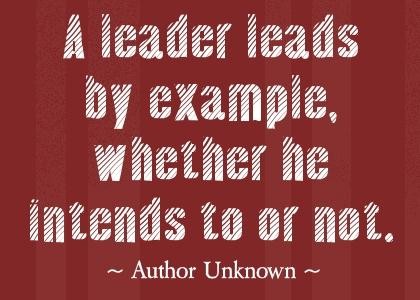
Hi stranger friends!
I was Voxing with George this morning, 🙂 and we were lamenting how life just exploded for us both this spring. He was busy getting engaged and we all know how time consuming wedding planning can be, 🙂 Add that to an influx of speaking engagements, he’s been in high demand! Not just speaking locally either…the man has been ALL over. Meanwhile, I’ve been busy getting a new job in a neighboring district and had an award thrown in, just for good measure.
Excuses? Possibly. The reality of our admin worlds? Definitely.
There isn’t a calm “season” in education, especially when you are trying to live to the fullest outside of your building. Recognizing the ebbs and flows of what we do is important to recognize as you contemplate leadership. We talk about modeling what we want to see from our staff, and this balance counts too! Administrators have to set boundaries and limits. The purpose of leading is to show through your walk and talk, that you are genuine. Being busy, and letting things slide at times, (gulp.) is a reality. It’s if and how you handle that slide that speaks loudest to your staff.
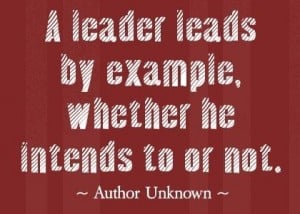
That being said, it’s the end of the school year. It’s time for EOY procedures, it’s time for making plans for the next year, it’s time for goodbyes. Thank you for joining us on this SAVMP adventure. I’m going to let George close us out proper, but I wanted to remind you to value the connections you have made through this program. Reach out to me, or George, or your mentee’s/mentor’s, if you ever have a need.
Good luck and happy summer!
Amber
When thinking about ways to bring about change or attempting to cultivate something new for your campus, where do you begin? Do you start with a formal staff meeting? Where you stand in front of the group and tell them what you want to see happen?
How effective has the been?
Conversation at dinner last night talk centered around those rockstar teachers on your campus. The ones who are willing to go above and beyond because its what should be done for kids, not because they are getting paid to be there. When I think about some of the crazy ideas that I wanted to see happening in classrooms, I think about the teachers I went to talk with to make that happen. When I wanted to see a bulletin board focused on the digital tools happening in the classroom, I knew exactly where to go to make that happen. This teacher knew my expectations, knew my vision, and what my end goal was with the something as simple as a bulletin board. (Vision! It all come back to vision!) I also had to balance what was asked of this particular rockstar in order to not detract from her teaching, or her relationships amongst the staff. Todd Nesloney wrote an inspiring post about how he embraced that role on his campus.
Who are your teacher leaders? How are you lifting them up and empowering them to be an example without ostracizing them from the rest of your staff? Share your strategies with your mentees this week so they can start keeping an eye out for ways to embrace and lift up those around them.
Have a great week!
Amber
In this hangout instructional leaders Jason Markey, Melissa Emler, Tony Sinanis, & Zach Snow discuss the importance of student voice and how to harness the power that passionate students are willing to share…if we listen.
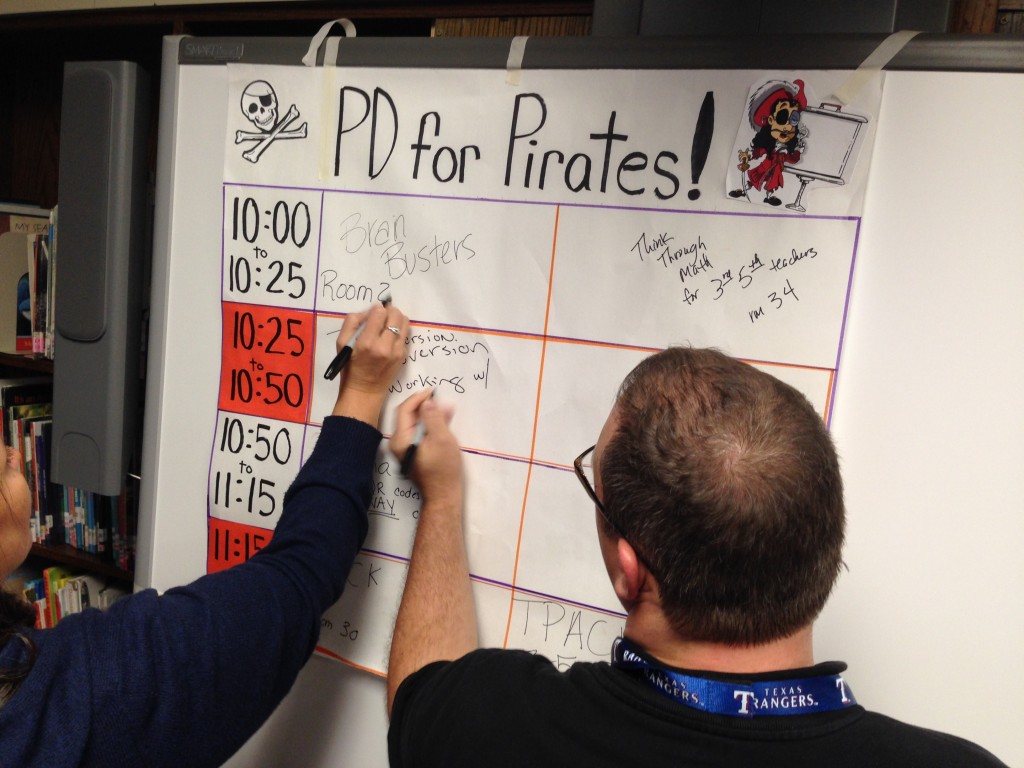
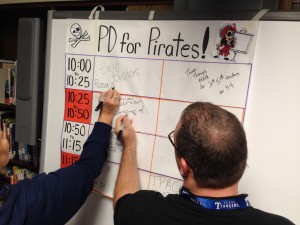 When planning for your staff development or professional development or growth opportunity…do you differentiate for your teachers?
When planning for your staff development or professional development or growth opportunity…do you differentiate for your teachers?
I know, I know…with everything else on your plate, now you’re supposed to add that to your list of to do’s? The answer is yes, if you want them to be completely dialed in and connected. In the same way that we expect our teachers to meet the needs of the learners in their class, we as administrators need to recognize the different levels of abilities and experiences on our staff. A differentiated approach to PD is needed to meet the diversity of teacher needs. PD should always be an evolving process of reflection and growth, and the way to accomplish that, is to get creative with how it’s planned and delivered.
Meeting teachers where they are isn’t nearly as complicated as it sounds. Depending on what you are discussing, teachers can be grouped according to familiarity or confidence in the topic. This can be discovered through a needs assessment or of their own volition. Allowing teachers to feel invested and providing a choice in what they are learning will almost certainly pay dividends in the long run. This will also reinforce your expectations within the classroom.
Grouping teachers is one way of differentiating. What else can you do?
- Give options in what your teachers are discussing, #edcamp style. I’ve even “prepped” teachers with a couple of topics that I knew that I wanted to see covered, but left most of the board blank, for their input.
- Allow conversations, not just “sit & get” sessions.
- Flip your meetings, to make the discussions more valid & transparent. Allow teacher voice!
- Let your groups of ability leveled learners be led by members of your own staff. Call on the experience in your building!
- Create a bucket list of activities you’d like to see in classrooms.
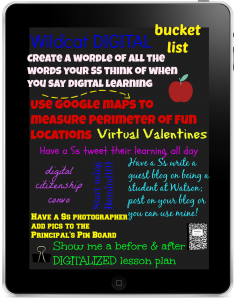
Supporting teachers begins with knowing that we should meet their individual needs in their own learning and growth. We no longer can be ok with the status quo, or a one size fits all mentality when it comes to PD. As the leader, it is up to you ensure that each educator has what they need in order to be the very best that they can be in their classroom. In the same way that students want to be interested, invested, and engaged, our teachers do too! Make your professional development an opportunity to be a role model and allow for a “different” development, a differentiation based one!
I challenge you this week to rethink your professional development. Share one way you plan on perking up and differentiating your PD!
I hope you have a great week and are warm where ever you are!
Amber

 Fearless. Courageous. Thoughtful. Visionary. What are some adjectives you think of when you think of the word “leader”?
Fearless. Courageous. Thoughtful. Visionary. What are some adjectives you think of when you think of the word “leader”?
Does the word “delegator” come to mind? It is a true art form, the ability to wisely and effectively delegate. It is a quality far more quiet than others, and yet can be one of the most crucial to a leader’s success. A principal who insists on maintaining all control and refuses to allow other’s to contribute or feel ownership of a campuses goals is missing the forest for the trees.
When I think of the leader who’s style I would most like to emulate, I think of someone who always empowered me to take on more, who encouraged me to believe in myself and gave me the opportunities to prove it. I was given extra after extra, and the encouragement to believe that not only could I handle it, but I would be able to handle it well. It truly molded me into who I am today, and even better, she STILL finds opportunities to build me up.
Tight fisted leadership doesn’t allow people to get on board. It is hard for someone to feel invested in a direction if they feel as if they are an outsider looking in. Delegating allows your team to take control, it empowers them to want to be better, to make ALL of you better. And as a leader, isn’t that what you want? Managers come and go, but leaders build other leaders and are never forgotten.
You are where you are for a reason. You are the LEAD learner, the INSTRUCTIONAL leader. You can spend 20 minutes every day doing something your secretary should be doing, which equates equates into 86 hours of doing that task during the next five years. Which is a more effective use of your time?
Obviously, this begins with smart hiring and being surrounded by people who you trust. If you find yourself saying, “So & so can’t handle that…so & so isn’t responsible enough for that.”, you may want to start with evaluating who is on your team. Find the “power points” on your campus, make sure they understand and believe in your vision, and start delegating. I had a conversation recently with a former custodian who worked in the building where I taught. He has since been promoted to custodial supervisor, and I love getting to catch up with him. He asked me who my heavy hitters were, and when I looked puzzled, gave me the most genuine compliment ever.
“Amber, you know you were the one we could all go to when we needed to get something done. You were that person on the staff, and everyone knew it. You’ve just got to find those power points on your campus now.”
3 easy ways to get started…
- Choose people who don’t need to be micromanaged. Make sure they are on board and up for the task.
- Ensure that your expectations are understood. Be clear if your goals and what the final product should look like.
- Follow up, check in, touch base…delegating doesn’t mean not following up! Give plenty of praise and credit where it is due.
By not delegating, you may give off the impression that you don’t think those around you are up for the task. Successful delegation of authority as a leadership style takes time and energy, but it’s worth the time and energy build other leaders. This week, have a conversation and decide who YOU can empower. Delegate!
Have a great week!
Amber
In this hangout instructional leaders Miguel Guhlin, Shannon Fuller, Ben Gilpen and Gerald Hudson discuss how they would handle three critical conversations with their staff.
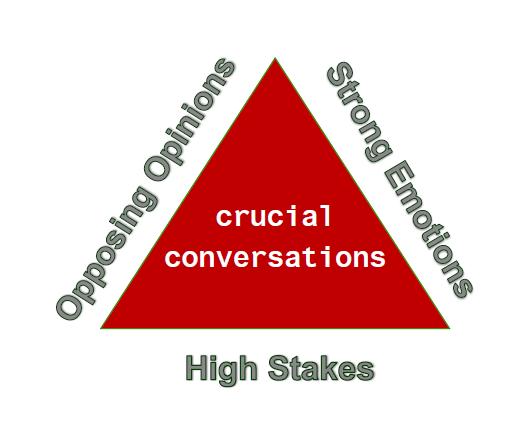
“We succeed or fail one conversation at a time.”
Hard conversations are never easy. Regardless of how “right” they may be, it doesn’t make it any easier on the person giving it, or the person receiving it. It can be one of the most difficult parts of an administrators job, and can easily turn into a disaster. When problems arise, in the worst companies people will withdraw into silence. In the best companies, people will hold a crucial confrontation, face to face and in the moment. And they’ll hold it well.
Dialogue example – Steps to Mastering a Crucial Conversation
Before embarking on a critical, or crucial, conversation…ask yourself these three questions:
- How important is it for the students or staff that I bring this up? Is it a “me” thing or is it an”impacting student success” thing?
- Is what is going on in the classroom unsafe or damaging to students or staff?
- What would happen if I didn’t have the conversation?
Other tips to keep in mind:
- Have a plan. Who will be involved in the conversation? Where will it take place? When will it happen? Will it be documented?
- What should your role be? Remember to listen to all parties involved. Be genuine in your efforts to resolve the issue at hand. Find a solution that fits. Beware of hidden agendas.
- You are the LEADER. It all begins and ends with you. The tone, intent, and follow through are all going to depend on how you handle the situation.
There will be a google hangout this week on “Critical Conversations”, stay tuned! (I will update this post when time and guests are decided!)
For your prompt for this week, blog about how you handle crucial conversations and at what point you step in to have them. What advice would you give to a new administrator in having to have a crucial, or fierce, conversation?
Have a great week, and where ever you are, stay warm!
Amber
Resources used and for more information:
Crucial Conversations: Tools for talking when stakes are high Kerry Patterson, Joseph Grenny, Ron McMillan, Al Switzler
Crucial Accountability: Tools for Resolving Violated Expectations, Broken Commitments, and Bad Behavior
Kerry Patterson, Joseph Grenny, David Maxfield, Ron McMillan, Al Switzler
Fierce Conversations: Achieving Success at Work and in Life, One Conversation at a Time
Susan Scott
Critical Conversations for Dummies
Dr. Christina Schlachter













